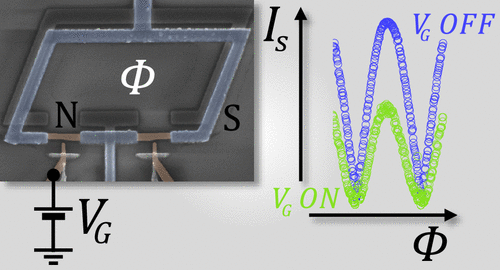当前位置:
X-MOL 学术
›
ACS Appl. Electron. Mater.
›
论文详情
Our official English website, www.x-mol.net, welcomes your
feedback! (Note: you will need to create a separate account there.)
Gate Control of the Current–Flux Relation of a Josephson Quantum Interferometer Based on Proximitized Metallic Nanojuntions
ACS Applied Electronic Materials ( IF 4.3 ) Pub Date : 2021-09-08 , DOI: 10.1021/acsaelm.1c00508 Giorgio De Simoni 1 , Sebastiano Battisti 1, 2 , Nadia Ligato 1 , Maria Teresa Mercaldo 3 , Mario Cuoco 4 , Francesco Giazotto 1
ACS Applied Electronic Materials ( IF 4.3 ) Pub Date : 2021-09-08 , DOI: 10.1021/acsaelm.1c00508 Giorgio De Simoni 1 , Sebastiano Battisti 1, 2 , Nadia Ligato 1 , Maria Teresa Mercaldo 3 , Mario Cuoco 4 , Francesco Giazotto 1
Affiliation

|
We demonstrate an Al superconducting quantum interference device in which the Josephson junctions are implemented through gate-controlled proximity Cu mesoscopic weak links. This specific kind of metallic weak links behaves analogously to genuine superconducting metals in terms of the response to electrostatic gating and provides a good performance in terms of current-modulation visibility. We show that through the application of a static gate voltage we can modify the interferometer current–flux relation in a fashion that seems compatible with the introduction of π-channels within the gated weak link. Our results suggest that the microscopic mechanism at the origin of the suppression of the switching current in the interferometer is apparently phase coherent, resulting in an overall damping of the superconducting phase rigidity. We finally tackle the performance of the interferometer in terms of responsivity to magnetic flux variations in the dissipative regime and discuss the practical relevance of gated proximity-based all-metallic SQUIDs for magnetometry at the nanoscale.
中文翻译:

基于近似金属纳米结的约瑟夫森量子干涉仪电流-通量关系的门控
我们展示了一种 Al 超导量子干涉装置,其中约瑟夫森结是通过栅极控制的邻近 Cu 介观弱链接实现的。这种特定类型的金属薄弱环节在对静电门控的响应方面类似于真正的超导金属,并且在电流调制可见性方面提供了良好的性能。我们表明,通过应用静态栅极电压,我们可以修改干涉仪电流 - 通量关系,其方式似乎与在门控弱链接中引入 π 通道兼容。我们的结果表明,干涉仪中开关电流抑制起源的微观机制显然是相位相干的,导致超导相位刚度的整体阻尼。
更新日期:2021-09-28
中文翻译:

基于近似金属纳米结的约瑟夫森量子干涉仪电流-通量关系的门控
我们展示了一种 Al 超导量子干涉装置,其中约瑟夫森结是通过栅极控制的邻近 Cu 介观弱链接实现的。这种特定类型的金属薄弱环节在对静电门控的响应方面类似于真正的超导金属,并且在电流调制可见性方面提供了良好的性能。我们表明,通过应用静态栅极电压,我们可以修改干涉仪电流 - 通量关系,其方式似乎与在门控弱链接中引入 π 通道兼容。我们的结果表明,干涉仪中开关电流抑制起源的微观机制显然是相位相干的,导致超导相位刚度的整体阻尼。











































 京公网安备 11010802027423号
京公网安备 11010802027423号